1993 CHEVROLET LUMINA change wheel
[x] Cancel search: change wheelPage 73 of 324
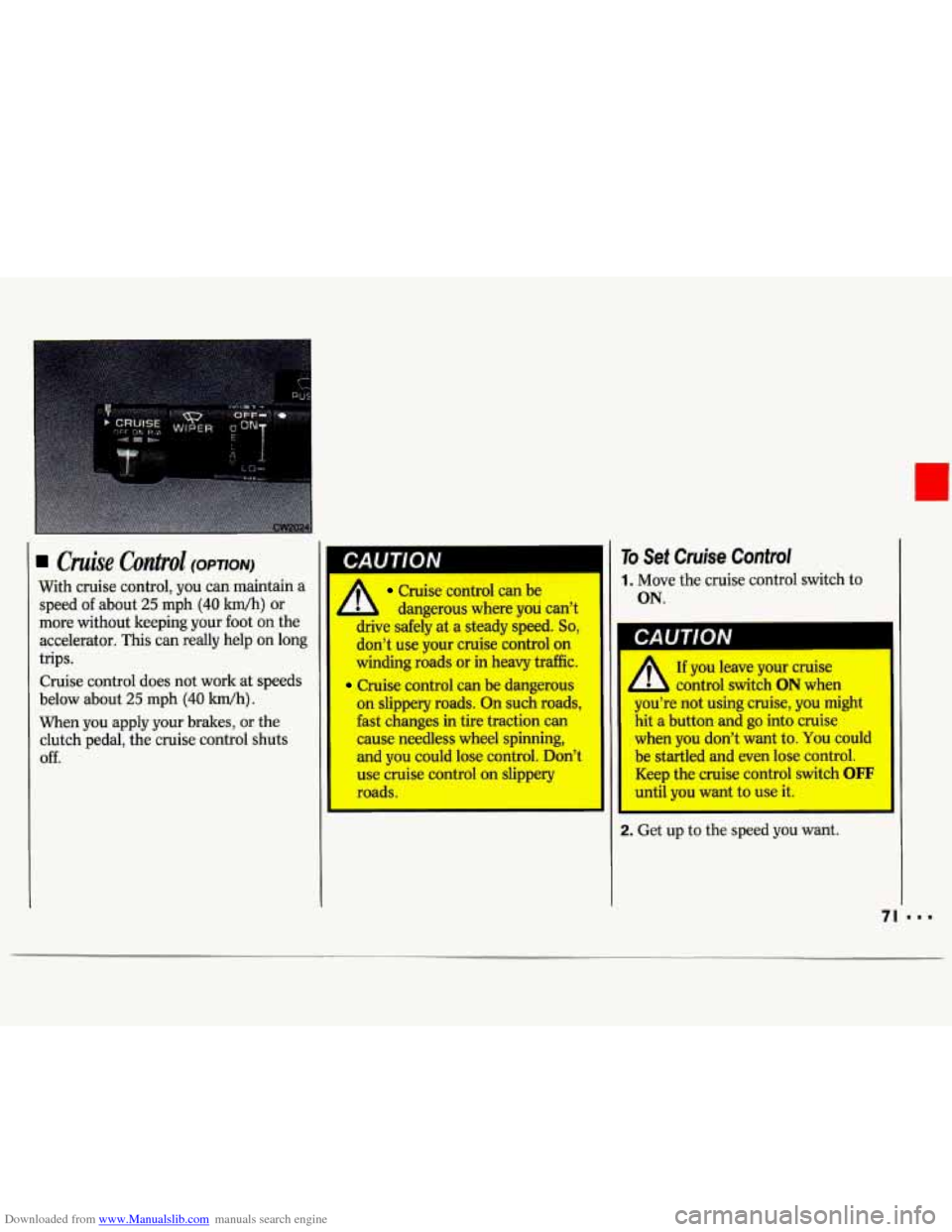
Downloaded from www.Manualslib.com manuals search engine Cruise Control (OPTION)
With cruise control, you can maintain a
speed of about 25 mph
(40 km/h) or
more without keeping your foot on the
accelerator.
This can really help on long
trips.
Cruise control does not work
at speeds
below about 25 mph
(40 lun/h).
When you apply your brakes, or the
clutch pedal, the cruise control shuts
Off.
I w
CAUTION
A dangerous where you can’t
Cruise control can be
drive safely at
a steady speed. So,
don’t use your cruise control on
winding roads or in heavy traffic.
Cruise control can be dangerous
on slippery roads. On such roads,
fast changes in tire traction can
cause needless wheel spinning,
and
you could lose control. Don’t
use cruise control on slippery
roads.
To Set Cruise Control
I. Move the cruise control switch
ON.
to
CAUTION
A If you leave your cruise
- control switch ON when
you’re not using cruise, you might
hit
a button and go into cruise
when you don’t want to.
You could
be startled and even lose control.
Keep the cruise control switch
OFF
until you want to use it.
2. Get up to the speed you want.
Page 130 of 324

Downloaded from www.Manualslib.com manuals search engine I
Your Driving and the Road
Anti-Lock Brakes (corvr.)
And this light on the instrument panel
will go on when you start your vehicle.
When you start your vehicle and begin
to drive away you may hear a
momentary motor or clicking noise and
you may even notice that your brake
pedal moves a little while this is going
on. This
is the ABS system testing itself.
If you have your foot on the brake
pedal, this check won’t happen until the
vehicle goes about
4 mph (6 km/h) or
until you take your foot off the brake
pedal. After
an
ABS stop, you may hear a
clicking noise the next time the vehicle
goes about
4 mph (6 Wh).
If there’s a problem with the anti-lock
brake system, the anti-lock brake
system warning light will stay on or
flash. See the
Index under Anti-Lock
Brake System Warning
Light.
.. .
Here’s how anti-lock works. Let’s say
the road is wet. You’re driving safely.
Suddenly an animal jumps out in front
You slam on the brakes. Here’s what
happens with
ABS.
of you.
A computer senses that wheels are
slowing down. The computer separately
works the brakes at each front wheel
and at the rear wheels.
The anti-lock system can change the
brake pressure faster than any driver
could. The computer is programmed to
make the most of available tire and road
conditions.
Page 131 of 324
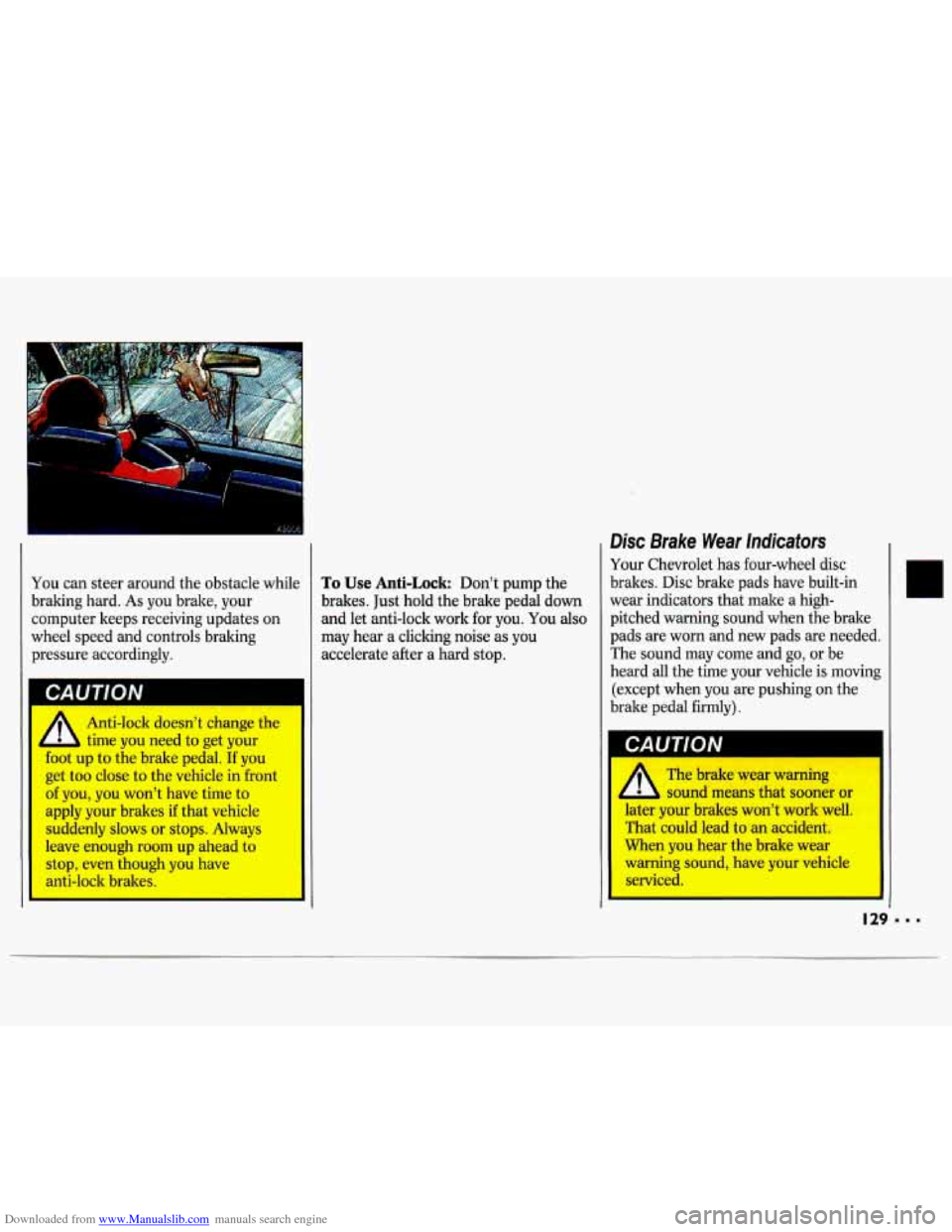
Downloaded from www.Manualslib.com manuals search engine You can steer around the obstacle while
braking hard.
As you brake, your
computer keeps receiving updates on
wheel speed and controls braking pressure accordingly.
inti-lock doesn’t change the
4 L time you need to get yoyr
foot up to the brake pedal. If you
get too close to the vehicle in front
of you, you won’t have time to
apply your brakes if that vehicle
suddenly slows or stops. Always
leave enough room up ahead to
stop, even though you have
anti-lock brakes.
To Use Anti-Lock: Don’t pump the
brakes. Just hold the brake pedal down
and let anti-lock work for you. You also
may hear a clicking noise as you
accelerate after a hard stop.
Disc Brake Wear Indicators
Your Chevrolet has four-wheel disc
brakes. Disc brake pads have built-in
wear indicators that make a high-
pitched warning sound when the brake
pads are worn and new pads are needed
The sound may come and go, or be
heard all the time your vehicle
is moving
(except when you are pushing
on the
brake pedal firmly).
A The brake wear warning
J sound means that sooner or
later your brakes won’t work well.
That could lead to an accident.
When you hear the brake wear
warning sound, have your vehicle
sewiced.
Page 134 of 324
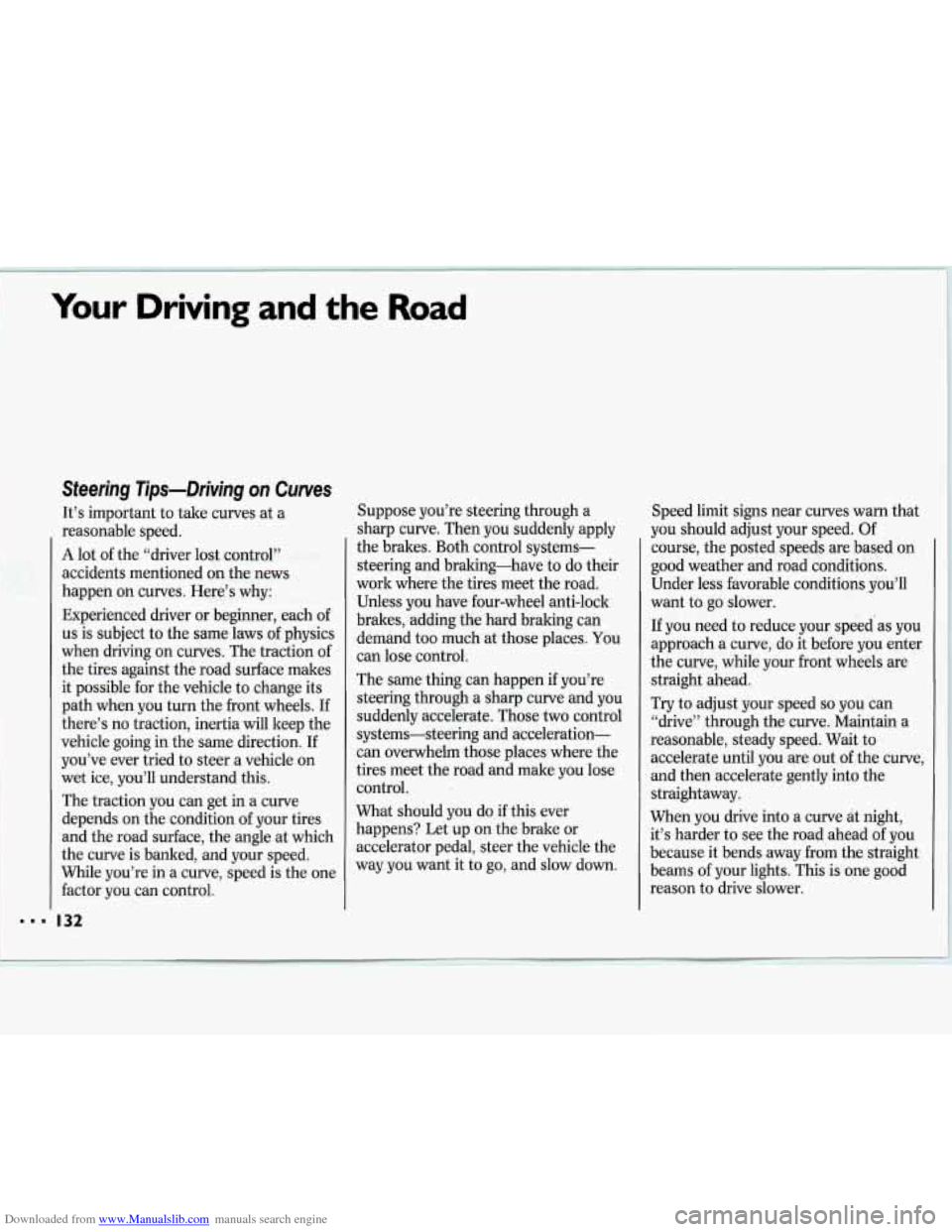
Downloaded from www.Manualslib.com manuals search engine Your Driving and the Road
Steering Tips-Driving on Curves
It’s important to take curves at a
reasonable speed.
A lot of the “driver lost control”
accidents mentioned
on the news
happen
on curves. Here’s why:
Experienced driver or beginner, each of
us is subject to the same laws of physics
when driving
on curves. The traction of
the tires against the road surface makes
it possible for the vehicle to change its
path when you turn the front wheels. If
there’s
no traction, inertia will keep the
vehicle going in the same direction. If
you’ve ever tried to steer a vehicle
on
wet ice, you’ll understand this.
The traction you can get in a curve
depends
on the condition of your tires
and the road surface, the angle at which
the curve is banked, and your speed.
While you’re in a curve, speed is the one
factor you can control. Suppose you’re steering through a
sharp curve. Then you suddenly apply
the brakes. Both control systems-
steering and braking-have to do their
work where the tires meet the road.
Unless you have four-wheel anti-lock
brakes, adding the hard braking can
demand too much at those places. You
can lose control.
The same thing can happen if you’re
steering through a sharp curve and you
suddenly accelerate. Those two control
systems-steering and acceleration-
can overwhelm those places where the
tires meet the road and make you lose
control.
What should you do if this ever
happens? Let up
on the brake or
accelerator pedal, steer the vehicle the
way you want it to go, and slow down. Speed limit signs near curves warn
that
you should adjust your speed. Of
course, the posted speeds are based
on
good weather and road conditions.
Under less favorable conditions you’ll
want to go slower.
If you need to reduce your speed’as you
approach a curve, do it before you enter
the curve, while your front wheels are
straight ahead.
Try to adjust your speed
so you can
“drive” through the curve. Maintain a
reasonable, steady speed. Wait to
accelerate until you are out of the curve,
and then accelerate gently into the
straightaway.
When you drive into a curve
at night,
it’s harder to see the road ahead of you
because it bends away from the straight
beams of your lights. This is one good
reason to drive slower.
132
Page 138 of 324
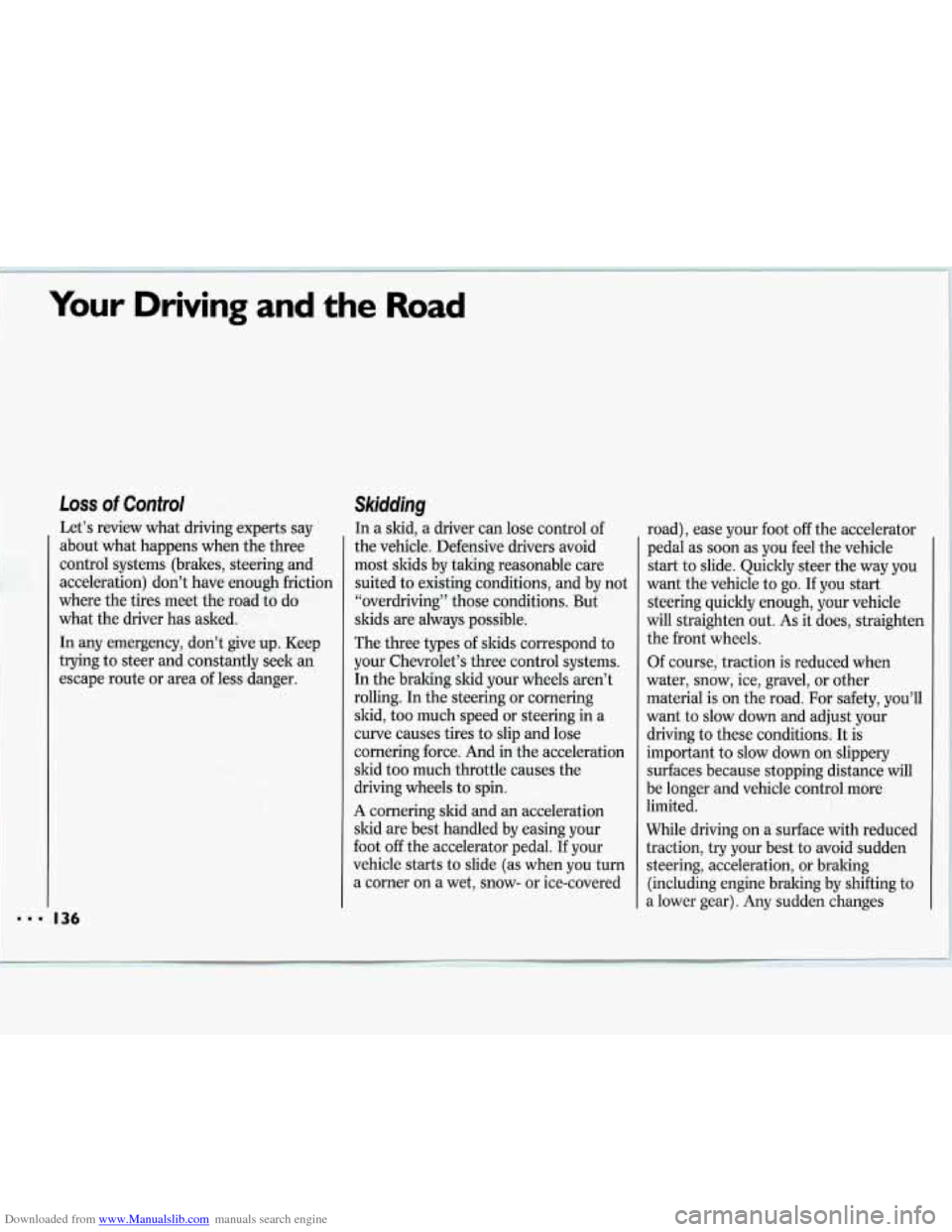
Downloaded from www.Manualslib.com manuals search engine Your Driving and the Road
Loss of Control
Let’s review what driving experts say
about what happens when the three
control systems (brakes, steering and
acceleration) don’t have enough friction
where the tires meet the road to do
what the driver has asked.
In any emergency, don’t give up. Keep
trying to steer and constantly seek an
escape route or area of less danger.
136
Skidding
In a skid, a driver can lose control of
the vehicle. Defensive drivers avoid
most skids by taking reasonable care
suited to existing conditions, and by not
“overdriving” those conditions. But
skids are always possible.
The three types
of skids correspond to
your Chevrolet’s three control systems. In the braking skid your wheels aren’t
rolling. In the steering or cornering
skid, too much speed or steering in a
curve causes tires to slip and lose
cornering force. And in the acceleration
skid too much throttle causes the
driving wheels to spin.
A cornering skid and an acceleration
skid are best handled by easing your
foot
off the accelerator pedal. If your
vehicle starts to slide (as when you turn
a corner on a wet, snow- or ice-covered road),
ease your foot
off the accelerator
pedal as soon as you feel the vehicle
start to slide. Quickly steer the way you
want the vehicle to go. If you start
steering quickly enough, your vehicle
will straighten out.
As it does, straighten
the front wheels.
Of course, traction is reduced when
I 1
water, snow, ice, gravel, or other
material is on the road. For safety, you’ll
I I
want to slow down and adjust your
driving to these conditions. It is
important to slow down
on slippery
surfaces because stopping distance will
be longer and vehicle control more
limited.
While driving
on a surface with reduced
traction, try your best to avoid sudden
steering, acceleration, or braking
(including engine braking by shifting to
a lower gear).
Any sudden changes
Page 149 of 324

Downloaded from www.Manualslib.com manuals search engine On the Road
Unless you are the only driver, it is good
to share the driving task with others.
Limit turns behind the wheel to about
100 miles (160 km) or two hours at a
sitting. Then, either change drivers or
stop for some refreshment like coffee,
tea or soft drinlts and some limbering
up. But do stop and move around. Eat
lightly along the way. Heavier meals
tend to make some people sleepy.
On two-lane highways or undivided
multilane highways that do not have
controlled access, you’ll want to watch
for some situations not usually found
on freeways. Examples are: stop signs
and signals, shopping centers with
direct access to the highway, no passing
zones and school zones, vehicles
turning left and right off the road,
pedestrians, cyclists, parked vehicles, and even animals.
Highway Hypnosis
Is there actually such a condition as
“highway hypnosis”? Or is it just plain
falling asleep at the wheel? Call it
highway hypnosis, lack of awareness, or
whatever.
There is something about an easy
stretch of road with the same scenery,
along with the hum of the tires on the
road, the drone of the engine, and the
rush of the wind against the vehicle that
can make you sleepy. Don’t let it
happen to you! If it does, your vehicle
can leave the road in
less than a second,
and you could crash and be injured.
What can you do about highway
hypnosis? First, be aware that it can
happen.
Then here are some tips:
Make sure your vehicle is well
ventilated, with a comfortably cool interior.
Keep your eyes moving. Scan the road
ahead and to the sides. Check your
rearview mirrors frequently and your
instruments from time to time. This
can help you avoid a fixed stare.
Wear good sunglasses in bright light.
Glare can cause drowsiness. But don’t
wear sunglasses at night. They will
drastically reduce your overall vision
at the very time you need all the
seeing power you have.
If you get sleepy, pull off the road into
a rest, service, or parking area and
take a nap, get some exercise, or both.
For safety, treat drowsiness on the
highway as an emergency.
As in any driving situation, keep pace
with traffic and allow adequate
following distances.
Page 157 of 324
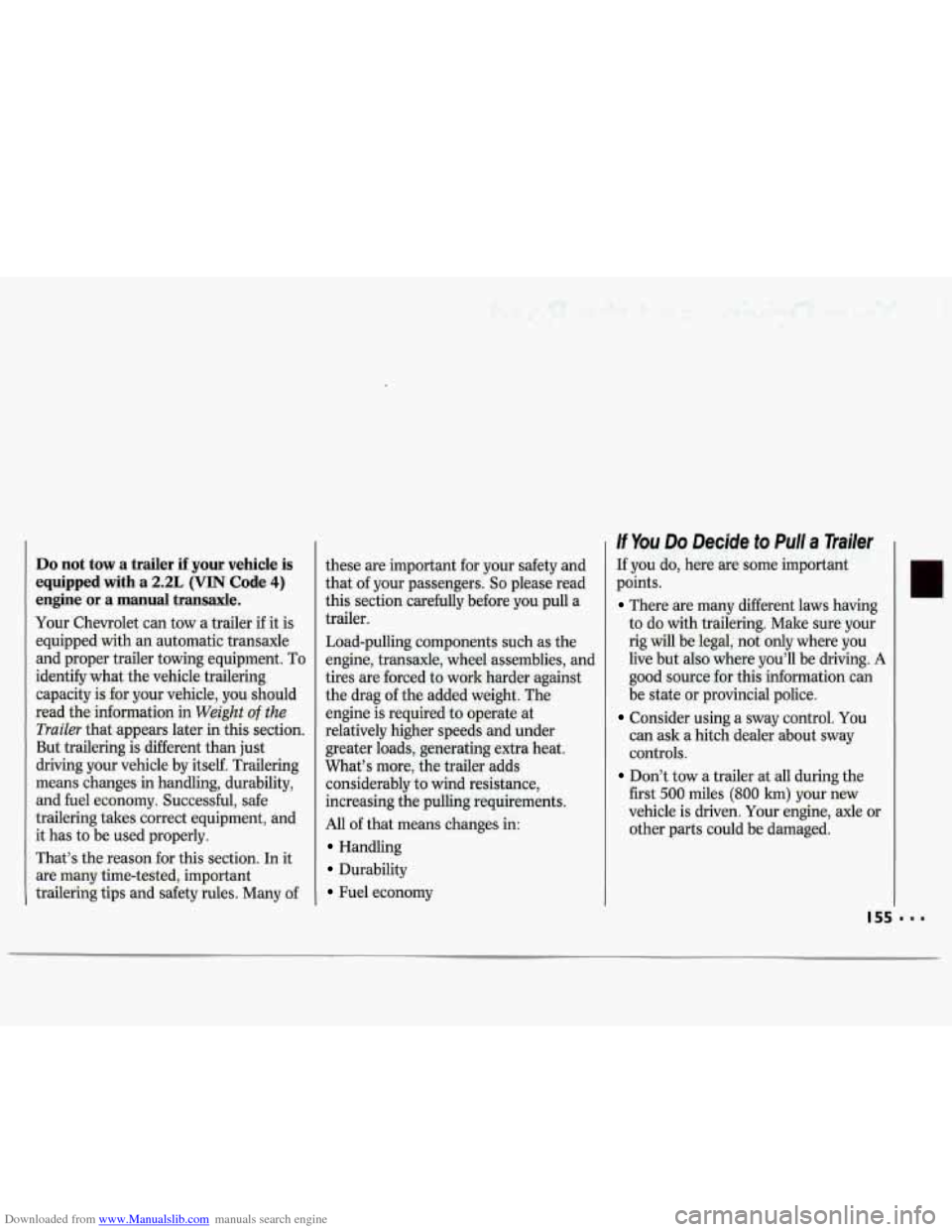
Downloaded from www.Manualslib.com manuals search engine Do not tow a trailer if your vehicle is
equipped with a 2.2L (VIN Code 4)
engine or a manual transaxle.
Your Chevrolet can tow a trailer if it is
equipped with an automatic transaxle
and proper trailer towing equipment. To
identify what the vehicle trailering
capacity is for your vehicle, you should
read the information in
Weight of the
Trailer
that appears later in this section.
But trailering is different than just
driving your vehicle by itself. Trailering
means changes
in handling, durability,
and fuel economy. Successful, safe
trailering takes correct equipment, and
it has to be used properly.
That’s the reason for this section. In it
are many time-tested, important
trailering tips and safety rules. Many of these are important
for your safety and
that of your passengers.
So please read
this section carefully before you pull a
trailer.
Load-pulling components such as the
engine, transaxle, wheel assemblies, and
tires are forced to work harder against
the drag of the added weight. The
engine is required to operate at
relatively higher speeds and under
greater loads, generating extra heat.
What’s more, the trailer adds
considerably to wind resistance,
increasing the pulling requirements.
All of that means changes in:
Handling
Durability
Fuel economy
If You Do Decide to Pull a Trailer
If you do, here are some important
points.
There are many different laws having
to do with trailering. Make sure your
rig will be legal, not only where you
live but also where you’ll be driving.
A
good source for this information can
be state or provincial police.
Consider using a sway control. You
can ask a hitch dealer about sway
controls.
Don’t tow a trailer at all during the
first
500 miles (800 lun) your new
vehicle is driven. Your engine, axle or
other parts could be damaged.
Page 171 of 324
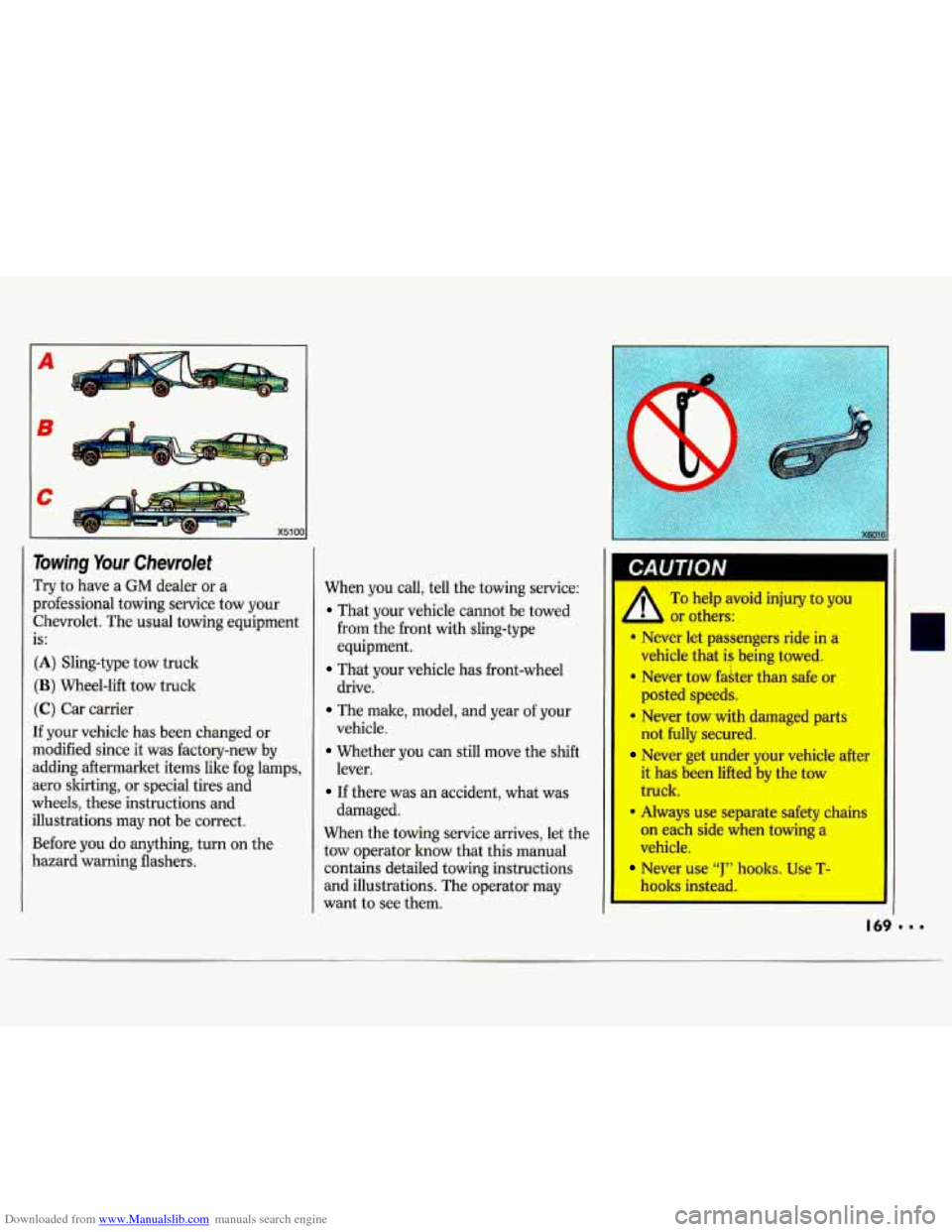
Downloaded from www.Manualslib.com manuals search engine A
B
Towing Your Chevrolet
Try to have a GM dealer or a
professional towing service tow your Chevrolet. The usual towing equipment
is:
(A) Sling-type tow truck
(B) Wheel-lift tow truck
(C) Car carrier
If your vehicle has been changed or
modified since it was factory-new by
adding aftermarket items like fog lamps,
aero slurting, or special tires and
wheels, these instructions and
illustrations may not be correct.
Before you do anything, turn on the
hazard warning flashers. When you call, tell
the towing service:
That your vehicle cannot be towed
from the front with sling-type
equipment.
drive.
vehicle. lever.
damaged.
That your vehicle has front-wheel
The male, model, and year of your
Whether you can still move the shift
If there was an accident, what was
When the towing service arrives, let the
tow operator know that this manual
contains detailed towing instructions
and illustrations. The operator may
want to see them.
PA I lTIn N
I
To help avoid injury to you
b or others:
Never kt paseengers ride in a
vehicle is being towed.
* Never tow €dter than safe or
posted speeds.
Never tow with damaged parts
not fully sawed.
Nwer get under your vehicle after
it has been lifted by the tow
truck,
on each side when towing a
vehicle.
Never use “J’’ hooks. Use T-
hooks instead.
* Always use separate safety chains
1